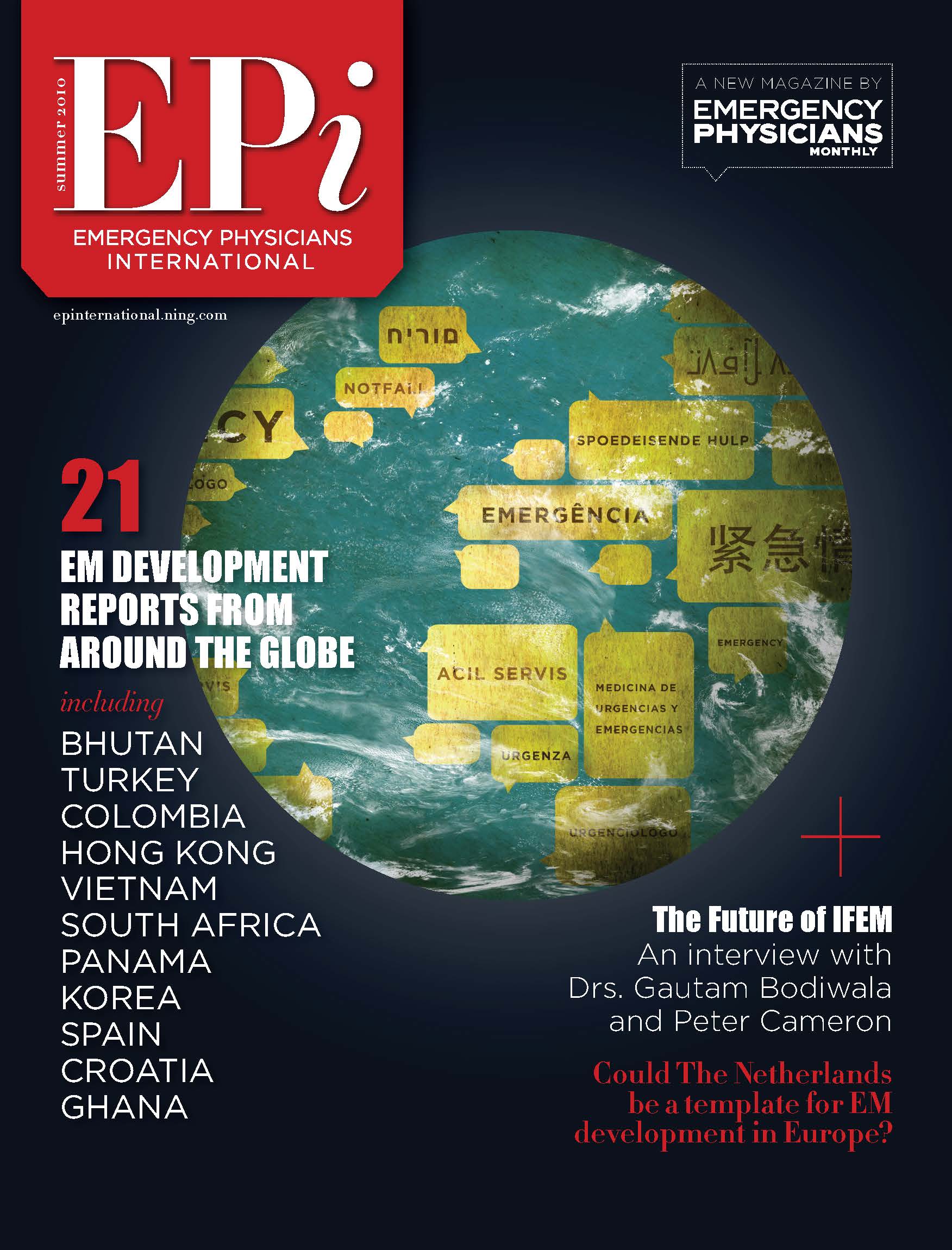Successful Emergency Medicine Demands In-Person Connection
When we reflect on changes made necessary by COVID-19, we often talk about what we have lost, what we are excited to bring back, and all the ways that the year was hard. In the midst of this unprecedented hardship, the incredible innovations that helped people feel “together” even when apart is opening doors for accessibility that were previously thought impossible. One of the areas where these innovations flourished is education -- in particular, the new face of conferences.
Conferences are exciting events filled with opportunities to learn, explore the world, and connect with people doing these activities alongside you. Having helped plan a few international conferences myself, I know this tour de force feels worth it when participants are finally together: talking, laughing, and overall helping move the academic world forward. I also know that these spaces are exclusive, and often are representative of the economic, social, and other barriers to educational mobility that many people face. Per a piece in Academic Practice in Ecology and Evolution, “in-person conferences are less accessible to academics and stakeholders that are unable to overcome some of these factors, which then act as a barrier to equal and inclusive participation. “ With the pandemic, virtual programming has removed many of these barriers to make the spaces more accessible, from the comfort of one’s own home. With this in mind, what does the future look like? I reached out to Professor Terry Mulligan, Vice President of the International Federation for Emergency Medicine (IFEM) and Board of Directors for the American Academy of Emergency Medicine (AAEM), Dr. Haywood Hall, Founder and Director of PACE MD, and Drs. Sanj Fernando and Mark Newcombe, leaders of Developing EM, to hear more about what this means for medical conferences’ futures around the world.
It was clear that each physician had given significant thought to accessibility over the past 18 months. Dr. Hall identified the harmful gap left by exclusive, in-person conferences:
“[It] has opened up conferences significantly, being able to participate online, it's creating a whole new kind of expectation. The more you look at it, especially in the international setting, these conferences are really expensive to be doing. I can pick any organization, but, [it’s] you know, $500, to $1,000 to participate, and then there's the hotel and airfare, etc. So, [the people who get] to go to those conferences, [are] people who are in the most developed countries, who have a reasonable economic status.”
Global Medicine: Inclusion Desperately Needed
In a world where infections travel from continent to continent in hours, global connection is imperative. Meaningful exchanges of scientific and cultural information will not be possible without international representation. From Developing EM, Dr. Fernando explained the impossibility of proceeding without these connections:
“Our conference relies on international delegates. If we run a conference and our international delegates are still a bit circumspect about flying and traveling internationally, then we won't have a conference. So, it makes sense to delay an international conference. I think the ground is shifting. I think this pandemic will have repercussions for decades to come. The years of people jetting off to meet other people are probably not dead and gone, but I think they will be significantly less. And, the ability to video conference has improved so much in such a short period of time that it now becomes a viable option.”
As conferences face these questions and consider how to engage people around the world in this shifting culture, there is also an opportunity for a new kind of inclusivity. When Dr. Hall discussed the topic, he offered insight to what this means:
“Here we are, trying to develop international emergency medicine, and there's people all over the world, there's over 60 countries that are full IFEM members, and very few can come. Maybe they have some other independent sources of income that allows them to come to these conferences internationally, but it's really rare. So, in a way, this has kind of democratized this whole process in potentially a very positive way. Now, the leaders, the participants, doctors and healthcare people, all of those people from almost any country could potentially participate at a relatively low cost. And likewise, the leadership of those countries can be involved in providing the talks and the workshops, and then it does become much more of [a global conversation]. There's obviously a huge component of medical tourism. There's been that touristic thing that's been there for international conferences. So the real work has to do with including people from all of these other countries, with much more limited means, that we need to access the information in order to participate meaningfully.”
The increased accessibility also allows for new kinds of collaboration. The ability to grow together is especially important in emergency medicine, because it is still a relatively new field that is very much still developing in many countries. Professor Terry Mulligan commented:
“Some things [do not need to] be reproduced. [For example,] we don't have to recalculate 100% of all of our national quality indicators. But there are some things that you can't just hand over, like legislative policy, financial and economic reimbursement strategy. But, if you have 35 examples from 35 other countries, or 50, examples from 50 other countries, then some of those could probably be used in country 51. What countries can learn is, you don't have to spend 20 years trying to figure out what kind of triage is best, you don't have to spend 50 years trying to find out what EMR system is best. Out of the 40 things you have to do to build an emergency system, 70% of them are shared by everybody, and 80% of them are shared by almost everybody.
“I got into the habit of listening not just for specific advice, but for the patterns [people] were describing. Those patterns can be used as templates in other countries, either in whole or in part.”
So, when virtual programming becomes viable and there is a clear social and academic benefit to continuing these virtual conferences, another question arises: why should we go back to in-person conferences? The kind of collaboration Dr. Mulligan is discussing is much easier to facilitate in person, where people can connect one to one about their lived experiences, in addition to the large group gatherings more typical of the formal academic content.
What’s Missing?
While the shift toward virtual programming has opened many doors, it looks like hybrid models are the future, rather than maintaining these international events on virtual platforms.
In-person interaction is necessary to accomplish all the less explicit goals of conference attendance. From the Developing EM team, and in parallel to what Dr. Mulligan also explained, Dr. Newcombe highlighted this reality:
“The educational stuff is important, and the actual translation of information through the standard conference format is a great way of getting people into a room and getting good information, but it can be done virtually. That is part of the benefit of our events, but the majority of it is something that we didn't anticipate originally: people get to meet one another. People collaborate as a result, on a scale that we had no expectation of. There have been some amazing, ongoing projects around the world, which only happen because people met at our conference.”
Beyond the inherent social value of in-person interactions, there are also logistical needs that cannot be met virtually. Dr. Hall outlined what it looks like in his organization, where conferences serve as a capstone and culmination of their work, but much of the programming is centered around training workshops. PACE’s training programs are divided into three categories: “knowledge,” “skills,” and “abilities.”
It is more practical to do the lectures which constitute “knowledge” online. This method increases the accessibility of each course by allowing people to engage when they are able, rather than creating barriers with the amount of time off people might need to attend a course. It makes it possible for people to slow lectures down, take them at their own pace, and truly get the most possible out of the experience. This way, people are not burnt out when it does come time to engage with the practical elements, and everyone is better served by the hybrid programming. However, the “skills” programming demands in-person training for practical reasons (as well as creating opportunities for irreplaceable network development):
“You have to be present, physically [present for] physical courses. Now, we do have simulations. There's low fidelity simulation with mannequins, there's higher fidelity with really souped up mannequins, and then there's ways of learning certain psychomotor skills online, at least the elements of it, but ultimately, there has to be some kind of real workshop type training.”
It is clear that people do not just attend these events for the programmed content itself, but even if they did, not all the programmed content would be possible on a virtual platform. People also attend conferences to network, to meet other people who share their interests, and to start the next great innovations in medicine over a drink or a meal, together. To get the benefits of virtual programming, while filling these gaps that cannot be filled remotely, it looks like hybrid conferences are here to stay.
Dr. Mulligan said it best, with regard to these needs:
“I think there are certain things that can't really be reproduced virtually. And I happen to think those are the sweetest best parts of the conference -- our interactions face to face between human beings. That's it. That's hard, too hard to lose.”







